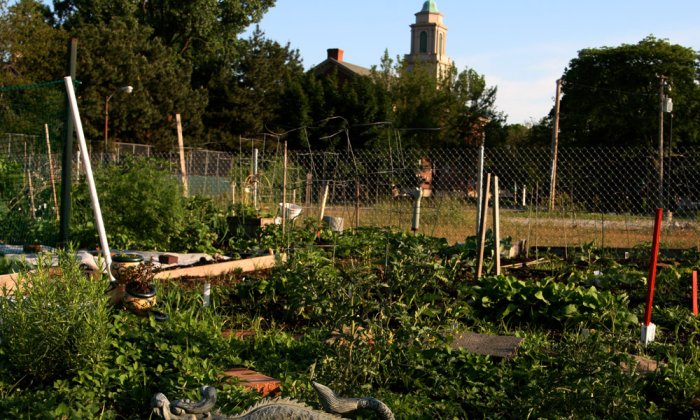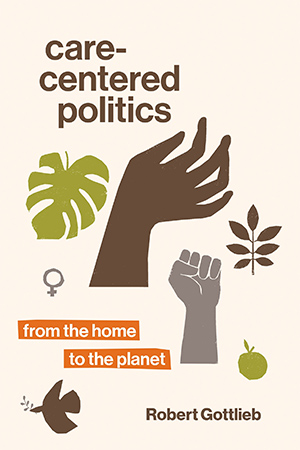Earth Care: A History of Community Gardening From Schools to Prisons

In early 2020, as lockdowns went into effect, pandemic gardens began popping up everywhere. It wasn’t the first time a crisis led to a resurgence of interest in gardening. After Hurricane Katrina hit — and then again in the early days of COVID-19 — Marguerite Green, executive director of Sprout NOLA, a New Orleans nonprofit related to community gardens, stressed the importance of growing food during a crisis. From maintaining garden plots and delivering food to those most vulnerable to having experienced gardeners raise seedlings at home to be distributed for home gardens, Sprout NOLA developed a number of activities designed to meet crisis or post-crisis needs. “This is actually why we build community,” she told the New York Times. “It’s to take care of each other in a time of need.”

Gardens have long been a source for care, comfort, creativity, and connection to others, as well as a source of fresh food. The Victory Gardens during World War II and an earlier version (the War Garden or Patriotic Garden) during World War I, for example, emphasized the importance of increased food availability. As many as 20 million people participated in the World War II Victory Gardens, and they were estimated to have provided as much as 40 percent of the country’s food supply at one point to help offset the food shortages and rationing due to the war. The 40 percent number has since been widely cited by garden advocates to identify the potential of gardens to supply a major quality food source during a crisis, particularly in low-income communities that lack access to fresh food, including fruits and vegetables.
As many as 20 million people participated in the World War II Victory Gardens, at one point providing as much as 40 percent of the country’s food supply.
But gardens have served multiple functions besides their food security role. Community gardens, for example, were first developed more than a century ago with the potato patch farms in Michigan in the midst of the recession of 1894 to provide not only a source of food but an important source of income for the unemployed. One hundred years later, in the midst of the industrial decline in Michigan and most notably Detroit, African American activists began to look to urban gardens as a source of renewal. That situation became especially pressing with the 2008–2009 Great Recession that led to large numbers of mortgage foreclosures, abandoned houses, and empty lots, most dramatically in low-income, African American neighborhoods.
As efforts were made to revive the auto industry and jump-start an industrial renewal in Detroit, the venerable organizer Grace Lee Boggs juxtaposed what she called illusions about industrial revival with a renewal of the city through urban gardens and related greening strategies. “You can bemoan your fate, or, as the African-American elders taught, you can plant gardens,” Boggs wrote in the Michigan Citizen. Boggs, who had been mentored by C. L. R. James and also interacted with civil rights activist Ella Baker, spoke of the need to reimagine the concept of work as opposed to jobs. We need to “take more responsibility for each other and for our community,” she wrote to promote Detroit Summer, the organization she and her husband, James Boggs, helped create in 1992. Her organization sought to have her celebrated African American elders (the “Gardening Angels”) interact with youths to undertake planting community gardens, painting public murals, creating bike programs, and hosting poetry workshops “to express their new thoughts.” These activities, she hoped, could serve as a “reconnection with earth and community” — a need magnified by Detroit’s search for renewal.
Aside from the environmental and community roles that Boggs referenced, gardens have served as a type of reconnection in other settings, such as schools and prisons. School gardens, similar to community gardens, have a history that dates back to the early 20th century. Part of the early impetus for developing school gardens was the desire for children, including from immigrant families, or families whose parents or grandparents had moved from the farm into the cities, to regain the language and skills of growing food. School gardens also became a source of fresh food for children during the two world wars, and a central feature of the farm-to-school program initiated during the late 1990s that soon extended to thousands of schools and in all 50 states in a little more than a decade.
One of the first farm-to-school programs in the United States at the Santa Monica–Malibu Unified School District (SMMUSD) was facilitated by the role of a school garden. Rodney Taylor, SMMUSD food service director, was a savvy food service buyer who had food service industry experience through a job at the Marriott hotel chain before joining the school district. Taylor, who grew up in a working-class background in Compton, California, initially expressed skepticism about a farm-to-school program, but reluctantly agreed to try it out as a pilot that he was convinced would fail.
The SMMUSD program called for farm direct produce to be offered as an alternative lunch option through what Taylor subsequently called a “farmers market salad bar.” Fifty percent of the children in the pilot school selected for the program qualified for free or reduced lunch — meaning their family’s income had to be below or slightly above the poverty line. Taylor decided to do an initial one-week test run, and gave the students on the first day the option of either pizza or the salad bar. To his astonishment, nearly three-quarters of the students chose the salad bar. Unbeknownst to him, the students had been provided a taste sampler in the weeks prior to the test pilot run of items that would be part of the salad bar. Many of the children compared the look and taste of the samples to the food they had grown, harvested, and tasted from the school garden, which had been established the previous year and was beloved by the students. “It’s from the garden,” they proclaimed, and that proved to be a tipping point for their willingness to try the new lunchtime salad bar. It also was a tipping point for Taylor, who would become one of the foremost advocates among school food service directors of farm-to-school programs and school gardens. He would later say that the experience helped him redefine his own position as a health champion who cared and was deeply engaged in providing fresh and healthy food to students who often lacked access to such food choices.
Both school and community gardens became enormously popular prior to the pandemic, even as they faced numerous barriers. Despite their ability to provide food, green and beautify the urban (and rural) landscapes, allow for much-needed physical activity, and create quiet and peaceful places, many community gardens have faced precarious futures, depending on the ownership and uses of the land. In a neoliberal age, private property trumps community benefits. Once private owners and sometimes public entities decide the land value has improved (often due to the community gardens), and that development can then proceed, gardens are plowed under, even when developments are then postponed, with the former garden sometimes reverting to vacant land.
Similarly, school gardens, despite their value as teaching tools, a source of physical activity, and ability to green school grounds, have been constrained by uncertain upkeep and limited resources, particularly during periods when schools are not in session. Teachers who help supervise garden work and do it as volunteers see it as an additional time burden in an already-overburdened schedule. Parents who help with school gardens, when allowed to do so (liability factors can sometimes prevent parent participation), are also limited by their own time constraints, including any long-term commitments. Even when policies by local and state governments, or school districts and school superintendents, identify certain goals, such as a 1995 proclamation by California superintendent of schools Delaine Eastin for “a garden in every school,” they often are unable to provide the resources or establish actual policies to implement such goals.
In a neoliberal age, private property trumps community benefits.
Nevertheless, community and school gardens have continued to flourish, and the benefits of gardens and gardening have extended to other institutions and places, such as prisons, domestic violence and abuse shelters, hospitals, and veterans’ facilities. During the past two decades, prison gardens, for example, evolved from innovative pilot projects at a handful of locations to a widespread initiative in a number of states, sometimes in conjunction with corrections departments that have come to recognize its benefits, sometimes belatedly — not least the reduction of recidivism rates. Aside from prisons, the concept of healing through gardening, a type of care-based horticultural therapy, has been widely applied in multiple other settings where the need for changed behavior is crucial, such as for batterers and those suffering from substance abuse. Unfortunately, the 2020–2021 pandemic impacted many of these programs, although adjustments were made to allow for continuing participation and even to expand their reach. This included programs enabling prison gardens to become a source of fresh food for pandemic-impacted and overextended food banks.
Backyard gardening and in the home is where gardens and gardening expanded most quickly during the pandemic, as they have after climate change-related events too. “People have always gardened in hard times, but food is only one part of that story,” argues Jennifer Atkinson, author of “Gardenland,” a 2018 book that highlighted the importance and value of gardening in seeking a connection with nature as well as desire for a sense of community. “There’s immense gratification that comes from work that gives you tangible results,” Atkinson told reporter Petra Mayer in a May 2020 interview with National Public Radio. Mayer then wrote about her own newfound pandemic-related obsession with gardening and how she wanted to share her passion with others, including colleagues at NPR.
The pandemic’s explosion of gardening itself emerged as a quintessential care activity in stressful times. Garden stores, seed stores, and mail-order businesses sold out many of their items, noting that among the buyers were numerous first-time home gardeners. First-timers often had little idea of how to proceed, but soon discovered the joys, comfort, and stabilizing aspects of gardening activities. “It’s that positive control” that gardening provides and that we so badly need in moments of uncertainty, says Rutgers University professor and agriculture extension agent Joel Flagler. “A feeling of ‘Hey I did something good here.’”
Robert Gottlieb is Professor Emeritus of Urban and Environmental Policy and the Founder and former Director of the Urban & Environmental Policy Institute at Occidental College. He is the coauthor of “Food Justice” and “Global Cities” and the author of “Care-Centered Politics,” from which this article is adapted.



